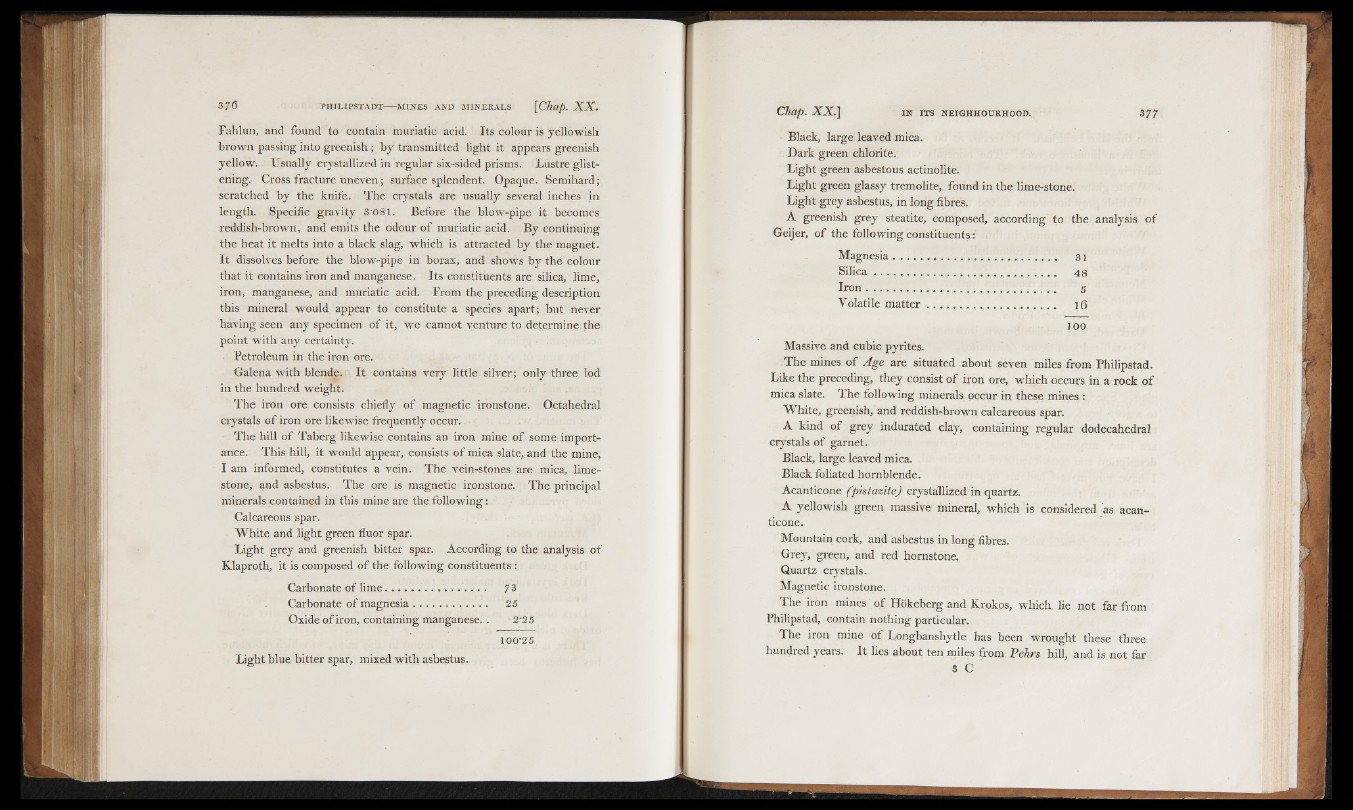
Fahlun, and found to contain muriatic acid. Its colour is yellowish
brown passing into greenish; by transmitted light it appears greenish
yellow. Usually crystallized in regular six-sided prisms. Lustre glistening.
Cross fracture uneven; surface splendent. Opaque. Semihard;
scratched by the knife. The crystals are usually several inches in
length. Specific gravity 3-0 8 1 . Before the blow-pipe it becomes
reddish-brown, and emits the odour of muriatic acid. By continuing
the heat it melts into a black slag, which is attracted by the magnet.
It dissolves before the blow-pipe in borax, and shows by the colour
that it contains iron and manganese. Its constituents are silica, lime,
iron, manganese, and muriatic acid. From the preceding description
this mineral would appear to constitute a species apart; but never
having seen any specimen of it, we cannot venture to determine the
point with any certainty.
Petroleum in the iron ore.
Galena with blende. It contains very little silver; only three lod
in the hundred weight.
The iron ore consists chiefly o f magnetic ironstone. Octahedral
crystals of iron ore likewise frequently occur.
The hill of Taberg likewise contains an iron mine of some importance.
This hill, it would appear, consists of mica slate, and the mine,
lam informed, constitutes a vein. The vein-stones are mica, limestone,
and asbestus. The ore is magnetic ironstone. The principal
minerals contained in this mine are the following:
Calcareous spar.
White and light green fluor spar.
Light grey and greenish bitter spar. According to the analysis of
Klaproth, it is composed of the following constituents :
Carbonate o f lime 73
Carbonate o f magnesia........................ 25
Oxide o f iron, containing manganese.. ; 2-25
100-25
Light blue bitter spar, mixed with asbestus.
Black, large leaved mica.
Dark green chlorite.
Light green asbestous actinolite.
Light green glassy tremolite, found in the lime-stone.
Light grey asbestus, in long fibres.
A greenish grey steatite, composed, according to the analysis of
Geijer, o f the following constituents:
Magnesia.................................................... 31
S ilic a ............................................................ 48
Iro n .............................................. 5
Volatile ma tter................................ 16
100
Massive and cubic pyrites.
The mines of Age are situated about seven miles from Philipstad.
Like the preceding, they consist o f iron ore, which occurs in a rock of
mica slate. The following minerals occur in these mines :
White, greenish, and reddish-brown calcareous spar.
A kind of grey indurated clay, containing regular dodecahedral
crystals of garnet.
Black, large leaved mica.
Black foliated hornblende.
Acanticone (pistazite) crystallized in quartz.
A yellowish green massive mineral, which is considered as acanticone.
Mountain cork, and asbestus in long fibres.
Grey, green, and red hornstone.
Quartz crystals.
Magnetic ironstone.
The iron mines o f Hokeberg and Krokos, which lie not far from
Philipstad, contain nothing particular.
The iron mine of Longbanshytle has been wrought these three
hundred years. It lies about ten miles from Cchrs hill, and is not far
s C